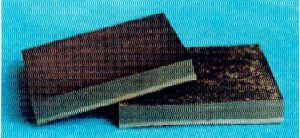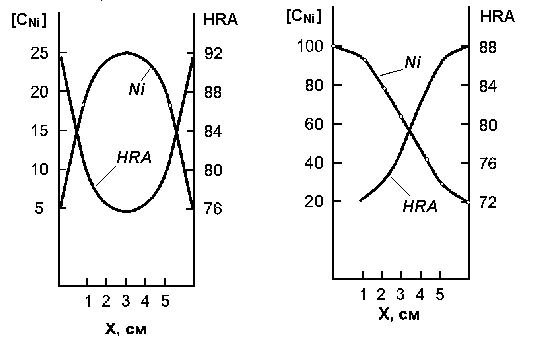

SHS functionally graded materials (FGM) are alloys consisting of hard grains of borides, carbides and other compounds of transition metals, which form a rigid continuous carcass, and a metallic binder (for example, nickel, titanium, aluminium) with its content varying permanently in the material volume. Due to their composition those materials have properties of both the hard alloy and the metal, i.e., they have high hardness and impact viscosity.
Those materials generated interest long ago. However, conventional industrial methods for producing hard alloys did not allow obtaining alloys with the desired gradient of binding metal concentration. FGM production with any volume distribution of binding metal became possible after developing self-propagating high-temperature synthesis (SHS).
The main idea of producing FGM by SHS is that a starting billet for synthesis should consist of two layers. The first layer is reactive but the second is inert and made of the pure metal. SHS process is initiated in the first layer. The metallic layer melts partly and penetrates into SHS products. Then the whole billet grew thick until it is dense, without pores. As a result a plate with variable volume content of binding metal is formed. Those materials were called SIGMA that means synthetic graded materials. Several FGM modifications have been developed by now.
The research showed that SIGMA has the most interesting properties when its one surface is hard (90 HRA) and the other is viscous and made of the pure metal. To destroy them, the force, which is 20 times greater than that for destroying similar homogeneous material, is required. Their impact viscosity is 3 times higher than that of the most high-strength hard alloys.
In ISMAN, the technological method for producing SIGMA alloys in the form of square (up to 90x90x10 mm), hexahedral (60 mm in the diameter of external circle and up to 10 mm in thickness) and round (up to 90 mm in diameter and up to 10 mm in thickness) plates has been developed. The plates have the following properties:
Chemical base |
TiC-Ni/Ni |
TiC-Ti/Ti |
TiB-Ti/Ti |
Density, g/cm3 |
5,6 – 5,8 |
4,4 – 4,6 |
4,4 – 4,6 |
Hardness, HRA |
Up to 90 |
Up to 84 |
Up to 86 |
Bending strength, MPa |
1000–1200 |
600–800 |
600–800 |

Due to those properties and also high thermal stability new alloys can find wide application in the following fields: